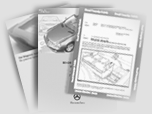DTC
 |
|
Possible cause |
Test step/Remedy 1) |
     |
   |
Not applicable for U.S. A. vehicles, continue to next test step. |
- |
     |
   |
Not applicable for U.S. A. vehicles, continue to next test step. |
- |
     |
   |
Not applicable for U.S. A. vehicles, continue to next test step. |
- |
     |
   |
Not applicable for U.S. A. vehicles, continue to next test step. |
- |
     |
|
Not applicable for U.S. A. vehicles, continue to next test step. |
- |
     |
|
Not applicable for U.S. A. vehicles, continue to next test step. |
- |
     |
|
Not applicable for U.S. A. vehicles, continue to next test step. |
- |
     |
|
Not applicable for U.S. A. vehicles, continue to next test step. |
- |
     |
|
Short circuit in ATA tow sensor (B33) |
 23 23  9.0 9.0 |
     |
|
CL safety time exceeded,
Pneumatic demand too high |
Pneumatic lines,
See DM, B&A, Vol. 2, Test Section
4.10 |
     |
|
CL safety time, Multi-contour Seat
Pneumatic demand too high |
Pneumatic lines,
Multi-contour Seat |
     |
|
Safety time, Manifold vacuum assist (MVA) demand exceeded
Pneumatic demand too high |
Pneumatic lines,
Multi-contour Seat |
     |
|
Safety time, Remote trunk lid release (RTR) exceeded
Pneumatic demand too high |
Pneumatic lines,
Multi-contour Seat |
     |
|
Not applicable for U.S. A. vehicles, continue to next test step. |
- |
     |
|
Not applicable for U.S. A. vehicles, continue to next test step. |
- |
     |
|
Not applicable for U.S. A. vehicles, continue to next test step. |
- |
     |
|
Alarm siren with auxiliary battery (H3/1) not installed, not version coded, defective, (as of 06/98) |
Version coding, see  31, 31,
Alarm siren,
 23 23  5.0 5.0 |
     |
|
Alarm (ATA) triggered via trunk lamp switch (S17/8) |
3.4
PSE  23 23 |
     |
|
Alarm (ATA) triggered via engine hood switch (S62) |
 23 23  1.0 1.0 |
     |
|
Alarm (ATA) triggered via left front door switch (S17/3) |
3.4
PSE  23 23 |
     |
|
Alarm (ATA) triggered via right front door switch (S17/4) |
3.4
PSE  23 23 |
     |
|
Alarm (ATA) triggered via left rear front door switch (S17/5) |
3.4
PSE  23 23 |
     |
|
Alarm (ATA) triggered via right rear front door switch (S17/6) |
3.4
PSE  23 23 |
     |
|
Reserve alarm input |
Currently not used. |
     |
|
Alarm (ATA) triggered via telephone |
Currently not used. |
     |
|
Alarm (ATA) triggered via FAX equipment |
Currently not used. |
     |
|
Alarm (ATA) triggered via ignition system |
Wiring. |
     |
|
Alarm (ATA) triggered via stop lamp switch (S9/1) |
 23 23  2.0 2.0 |
     |
|
Not applicable for U.S. A. vehicles, continue to next test step. |
- |
     |
|
Not applicable for U.S. A. vehicles, continue to next test step. |
- |
     |
|
Alarm (ATA) triggered via Anti-tow sensor (B33) |
 23
23  7.0, 7.0,
 23 23  9.0 9.0 |
     |
|
Circuit 30 interupted while in armed state |
DM,
B&A, Vol. 2.1, Test Section 7.1,  23
23 |
     |
|
Not applicable for U.S. A. vehicles, continue to next test step. |
- |
     |
|
Not applicable for U.S. A. vehicles, continue to next test step. |
- |
     |
|
PSE (A37) |
Replace PSE (A37) |


 Printable
version
Printable
version


 Printable
version
Printable
version